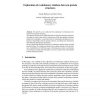148 search results - page 1 / 30 » The evolutionary capacity of protein structures |
RECOMB
2004
Springer
14 years 9 months ago
2004
Springer
In nature, one finds large collections of different protein sequences exhibiting roughly the same three-dimensional structure, and this observation underpins the study of structur...
BIRD
2008
Springer
13 years 11 months ago
2008
Springer
Abstract. We describe a new method for the exploration of evolutionary relations between protein structures. The approach is based on the ESSM algorithm for detecting structural mu...
BMCBI
2010
13 years 9 months ago
2010
Background: Partitioning of a protein into structural components, known as domains, is an important initial step in protein classification and for functional and evolutionary stud...
BMCBI
2004
13 years 9 months ago
2004
Background: The functional selection and three-dimensional structural constraints of proteins in nature often relates to the retention of significant sequence similarity between p...
ISBRA
2010
Springer
13 years 7 months ago
2010
Springer
The study of non-sequential alignments, with different connectivity of the aligned fragments in the proteins being compared can offer a more complete picture of the structural, evo...

